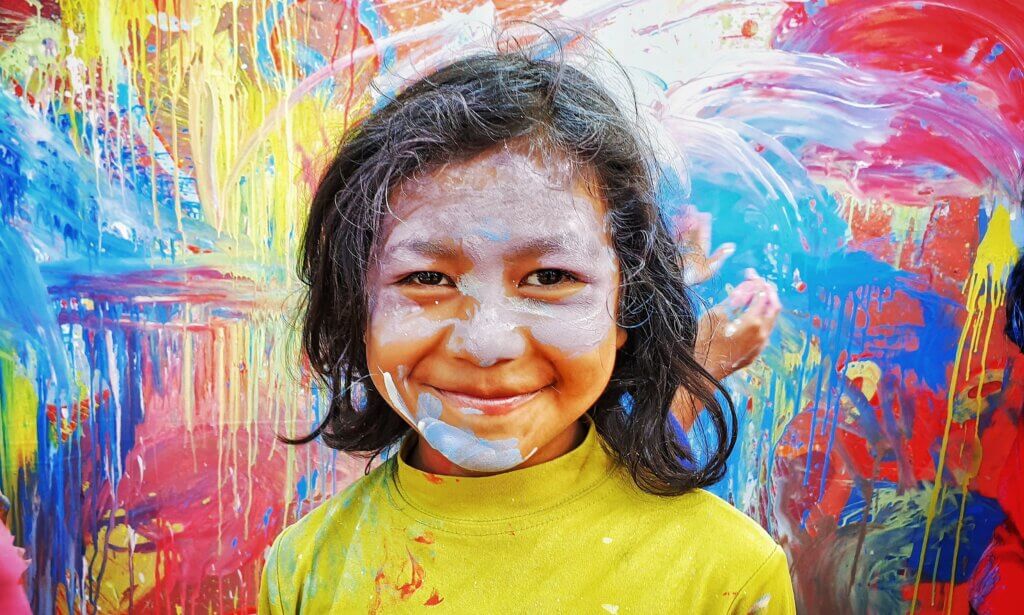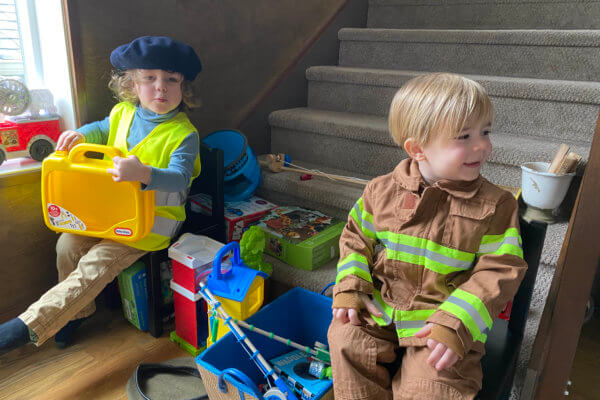Getting comfortable with messy play

I’ve been working with kids for over 15 years, and I’ve cleaned up a fair share of messes in that time. I wasn’t someone who initially leaned into messy play because it can be gross, stressful, overwhelming, and because I could always come up with something else that’s fun to do instead. However, the longer I’ve been doing this, the more I’ve gotten not only comfortable, but actually have started enjoying, inviting, celebrating, and really leaning into messy play time! Here’s my why, my how, and some tips I’ve learned along the way.
What is messy play?
ALL kids make messes, but I’m not talking about a big bin of train tracks that’s gotten dumped out or a trashed playroom. I’m thinking about intentional tactile, sensory play. This can look so many different ways: paint, Play-Doh, kinetic sand, shaving cream, sensory play bins full of all kinds of items, water play, cooking together, “making potions” (one of my nanny kids’ favorites), or good, old-fashioned mud kitchen play, just to name a few! The options are truly limitless. I consider messy play anything where kids are getting into something tactile and having a sensory experience, which often leads to a fair amount of clean up afterward.
The benefits of messy play with kids
Why would we want kids to get messy, especially when we work in other peoples homes and need to respect and care for their space? It can feel counterintuitive, but messy play & sensory play has huge benefits for kids! There are physical benefits: squeezing, moving, crushing, gripping, and crunching help those little hands build fine-motor strength while they’re playing. (This pays off big time for pre-writing and writing!) They are also experiencing many textures: smooth, slippery, wet, sticky, gooey! There are social-emotional benefits as well. Kiddos learn that messes happen, that being messy is okay, and that we clean up after we get messy. It also offers problem-solving skill building too: how do we clean this up? If there are multiple children playing, they practice taking turns, navigating around others, and experimenting. Does my friend like it when I smear paint on them? Do I like it when they smear paint on me? We get to throw in a little language development as well by describing textures and narrating what we see.
Unstructured, messy play is fun! Kiddos both crave it and need it.
Plan ahead
If you’re someone who has been hesitant to dig into messy play, plan ahead and start small. Have a chat with your nanny family & figure out what their expectations around messy play might be. Consider where to do the messy play. I almost always lead messy play activities in the kitchen so we can be near the sink, but you can also do this in the bathtub, outside in the grass, or lay down a cheap plastic tablecloth on the floor in an area that makes sense. Limit the messy play to a Tuff Tray or bin, if that’s helpful. Consider the temperament of your nanny child. Some kids dig right in and want a lot of the materials. Some kids might only dip a finger tip in or will need to watch first. That’s all okay!
Have materials ready ahead of time so you’re not leaving your little friends alone with the messy materials. Do you need paper towels, Clorox wipes, baby wipes, or rags nearby? Are you and your nanny kids wearing smocks or aprons to protect clothing (I love these cheapie smocks from Ikea)? What tools will they use to explore and play with your materials? Do they need cups, tongs, scoopers, droppers, spoons? Do pets need to be put in a different room for this activity? Can it be done when little siblings are napping?
Let your nanny kids know about expectations and guidelines before presenting the material. Where does the material need to stay? Can we smell it? Can we taste it?
Start small
Water play counts as messy, sensory play and is pretty darn easy to clean up! Let them “do dishes,” operate a car wash for their toy cars, or give baths and showers to their dolls. This foam is fun and is made of water and soap – also easy to clean! Shaving cream smells great and just needs to be rinsed off. You can step things up as you’re comfortable. Consider painting – an infant might have a paint experience inside a ziplock bag, then in a few months be ready to explore a few small drops of paint on their high chair tray, and then move into mixing a few different colors. Use washable paint; it truly wipes right up!
Clean up together
After the messy playtime is over, it’s time to clean up. This may have been the biggest shift for me because I’ve moved from thinking, “Ugh! I don’t want to clean this all up!” to knowing that my nanny kids and I are a team, and we’re going to cooperatively work on this together. It’s not their job to have fun and my job to clean it up after- cleaning up is part of the activity. It doesn’t have to be a bummer. You model this with your attitude towards the clean up. Create the norm in the household that the cleanup is part of the play process. There’s a beginning, the setup. There’s the middle, the project. There’s the end, clean up.
One of the children in my care reminds me almost daily that “teamwork makes the dream work” because that’s how we operate! Be specific when giving directions, and thank them genuinely for their help afterward. Depending on the ages of your nanny charges, different clean-up help will be appropriate. Even toddlers and preschoolers can help with wiping, sweeping, rinsing, and putting things back where they go. Our early years lead, Julietta Skoog, has a wonderful story about cleaning up her wallpaper after a smoothie hit it and really finding mindfulness in that moment. I love that!
Find your zen while you clean up. What do you feel? Smell? See?
Enjoy the scent of the soap & the feeling of the warm water on your hands. For me, it’s incredibly satisfying to see the materials after they’ve all been cleaned.
Other tips
Some other things that I’ve found helpful have been using low-lighting and playing slow, quiet music to keep the energy in the room a little calmer.
Challenge yourself to let go of your preconceived expectations and end results for the activity. Consider if your rules for the materials can flex. Let them mix the damn Play-Doh! We can make more Play-Doh! The benefits they’re getting exploring their messy play on their own trumps our objectives. Sally Haughey says, “think verb, not noun” when you’re inviting children to play. Process over product!
Listen to your body. If you’re noticing yourself getting overwhelmed, then it’s probably time to start cleaning up. You don’t want to let it go on too long, flip your lid, and then be dealing with the clean up while everyone is maxed out! Breathe.
If your nanny charge is truly an absolute mess after the activity, strip them down, throw clothes in the laundry, and get them straight into the bathtub. Kids are washable!
Messy play ideas
- Make slime
- Play-doh
- Clay
- Finger paint
- Mud
- Water
- Soapy foam
- Taste-safe sensory bins
- Shaving cream
- Baking soda & vinegar experiments
- Experiment with color mixing with water & food coloring
- Make a “potion” (This consists of my nanny kids and I scrounging around the kitchen for random ingredients, combining, stirring, and voila! A potion.)
- Cook together
- Popsicle bath
- Floam
- Cloud dough
- Oobleck
- Water beads
- Pudding paint
- Paint the snow
- Wet sidewalk chalk
- Bathtub paint
- Ice cube paint
- Dig a hole
What do you think? Does facilitating messy play come easily to you? The more I do it, the more I enjoy it! Nanny families truly appreciate seeing their kids having a blast, getting messy, and not being responsible for prepping & cleaning it up themselves! Remember that kids can always be cleaned, clothing can always be washed, and the memories and laughter that naturally accompany messy play are well worth the effort.
Check out our tips for getting into risky play & pretend play with your nanny kids, too!





Comments